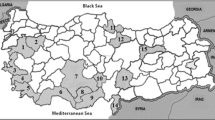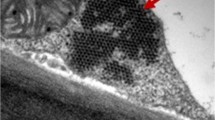Abstract
Two sap-transmissible virus isolates from bean (Phaseolus vulgaris L.) were identified as bean common mosaic virus (BCMV) on the basis of particle size and morphology, serology, non-persistent aphid transmission, very limited host range, and symptoms and seed transmission in bean.
In bean varietal reaction both isolates differed from each other and all six Dutch BCMV strains described before. From literature data it may be concluded that they also differ from thirteen other strains described elsewhere. The isolate from Peruvian seed may be related to strains reported from Costa Rica and Peru, but these have been described incompletely.
The two isolates obtained at Wageningen are therefore described as new strains and designated BCMV-NL7 and BCMV-NL8. The latter seems unusual in its extremely high dilution end point, in its serological affinity to both BCMV and BYMV, and in not being infectious toChenopodium amaranticolor andC. quinoa.
Tetragonia expansa proved to be a new local lesion host of BCMV. There is an urgent need for international standardization of strains of BCMV.
Samenvatting
Twee met sap overgaande virusisolaten uit boon (Phaseolus vulgaris) (B53 uit in de kas uit Peruaans zaad opgekweekte planten en B54 uit planten van een Nederlandse bonekruising) werden geïdentificeerd als bonerolmozaïekvirus (BCMV). Dit gebeurde op grond van deeltjesgrootte en-vorm, serologische eigenschappen (Tabel 3), houdbaarheid van het infectievermogen in uitgeperst plantesap (Tabel 2), overdracht door bladluizen (Tabel 4), beperkte waardplantenreeks (Tabel 1) en symptomen (Fig. 1–3) en zaadoverdracht in boon.
In reactie op differentiërende bonerassen verschilden beide isolaten van elkaar en van alle zes andere, to dusver in Nederland beschreven stammen van BCMV (Tabel 5). Uitgaande van gegevens uit de literatuur lijken ze ook te verschillen van de dertien elders beschreven stammen (Tabel 6). B53 lijkt wel wat op stammen uit Costa Rica en Peru, maar deze zijn onvolledig beschreven.
De twee in Wageningen verkregen isolaten worden daarom opgevat als nieuwe stammen en aangeduid als BCMV-NL7 en BCMV-NL8. De laatste wijkt sterk af door zijn ongewoon hoge verdunningseindpunt, in zijn even sterke serologische verwantschap met het bonerolmozaïekvirus als met het bonescherpmozaïekvirus (Tabel 3) en in het niet kunnen aantasten vanChenopodium amaranticolor enC. quinoa.
Tetragonia expansa werd ontdekt als een nieuwe lokale-lesieplant voor het bonerolmozaïekvirus.
Geconstateerd wordt dat er een grote behoefte bestaat aan internationale standaardisatie in de beschrijving van de stammen van het virus.
Similar content being viewed by others
References
Alconero, R. & Meiners, J. P., 1974. The effect of environment on the response of bean cultivars to infection by strains of bean common mosaic virus. Phytopathology 64: 679–682.
Baggett, J. R., Frazier, W. A. & McWhorter, F. P., 1966. Sources of virus resistance in beans. Pl. Dis. Reptr 50: 532–536.
Bercks, R., 1960. Serologische Untersuchungen zur Differenzierung von Isolaten desPhaseolus-Virus 2 und ihrer Verwandschaft mitPhaseolus-Virus 1. Phytopath. Z. 39: 120–128.
Bos, L., 1970a. The identification of three new viruses isolated fromWisteria andPisum in the Netherlands, and the problem of variation within the potato virus Y group. Neth. J. Pl. Path. 76: 8–46.
Bos, L., 1970b. Bean yellow mosaic virus. C.M.I./A.A.B. Descr. Pl. Viruses, no. 40, 4 pp.
Bos, L., 1971a. Bean common mosaic virus. C.M.I./A.A.B. Descr. Pl. Viruses, no. 73, 4 pp.
Bos, L., 1971b. Circular letter to members of the International Working Group on Legume Viruses involved in research on BCMV, May 14, 1971.
Bos, L., Hagedorn, D. J. & Quantz, L. 1960. Suggested procedures for international identification of legume viruses. Tijdschr. Plziekt. 66: 328–343.
Bos, L. & Maat, D. Z., 1974. A strain of cucumber mosaic virus, seed-transmitted in beans. Neth. J. Pl. Path. 80: 113–123.
Dean, L. L. & Hungerford, C. W., 1946. A new bean mosaic in Idaho. Phytopathology 36: 324–326.
Dean, L. L. & Wilson, V. E., 1959. A new strain of common bean mosaic in Idaho. Pl. Dis. Reptr 43: 1108–1110.
Drijfhout, E., 1977. Genetic interaction betweenPhaseolus vulgaris L. and bean common mosaic virus and its strains. Agric. Res. Rep. 872, Pudoc, Wageningen.
Drijhout, E. & Silbernagel, M. J., 1977. Identification and classification of strains of bean common mosaic virus. Neth. J. Pl. Path. 83: in manuscript.
Férault, A. C., Spire, D., Bannerot, H., Bertrandy, J. & Le Tan, T., 1969. Identification dans la région parisiene d'une marbrure du haricot comparable au bean southern mosaic virus (Zaumeyer et Harter). Annls Phytopath. 1: 619–626.
Frandsen, N. O., 1952. Untersuchungen zur Virusresistenzzüchtung beiPhaseolus vulgaris L. 1. Phytopathologische Untersuchungen. Z. PflZücht. 31: 381–420.
Gamez, R., Osores, A. & Echandi, E., 1970. Una raza nueva del virus del mosaico común del frijol. Turrialba 20: 397–400.
Hubbeling, N., 1963. Complicaties bij de toetsing van bonerassen op resistentie tegenPhaseolus virus 1 ten gevolge van het voorkomen van afwijkende virusstammen. Meded. LandbHoogesch. OpzoekStns Gent 28: 1025–1033.
Hubbeling, N., 1972. Resistance in beans to strains of bean common mosaic virus. Meded. Fak. LandbWetensch. Gent 37: 458–466.
Hungerford, C. W., 1952. Disease resistant field beans for Idaho. Circ. Idaho agric. Exp. Stn 118: 11 pp.
Moreno, R., Gamez, R. & Gonzalez, L. C., 1968. El virus del mosaico común del frijol (Phaseolus vulgaris L.) en Costa Rica. Turrialba 18: 257–263.
Quantz, L., 1957. Ein Schalentest zum Schnellnachweis des gewöhnlichen Bohnenmosaikvirus (Phaseolus-Virus 1). NachrBl. dt. PflSchutzd. Stuttg. 9: 71–74.
Quantz, L., 1961. Untersuchungen über das gewöhnliche Bohnenmosaikvirus und das Sojamosaikvirus. Phytopath. Z. 43: 79–101.
Richards, B. L. & Burkholder, W. H., 1943. A new mosaic disease of beans. Phytopathology 33: 1215–1216.
Rudorf, W., Die Übertragung der Resistenz gegen die Bohnenmosaikviren 1 (gewöhnliches Bohnenmosaik) und 2 (gelbes Bohnenmosaik) ausPhaseolus coccineus in fertile Bastardpflanzen aus der KreuzungPhaseolus vulgaris × Phaseolus coccineus. Naturwissenschaften 42: 19–20.
Rudorf, W., 1958. Ein Beitrag zur Genetik der Resistenz gegen das Bohnen-Mosaikvirus 1. Phytopath. Z. 31: 371–380.
Silbernagel, M. J., 1969. Mexican strain of bean common mosaic virus. Phytopathology 59: 1809–1812.
Skotland, C. B. & Burke, D. W., 1961. A seed-borne bean virus of wide host range. Phytopathology 51: 565–568.
Want, J. P. H. van der, 1954. Onderzoekingen over virusziekten van de boon (Phaseolus vulgaris L.). Meded. Inst. plziektenk. Onderz. 85: 84 pp.
Zaumeyer, W. J. & Goth, R. W., 1964. A new severe symptom-inducing strain of common bean mosaic virus. Phytopathology 54: 1378–1385.
Author information
Authors and Affiliations
Rights and permissions
About this article
Cite this article
Drijfhout, E., Bos, L. The identification of two new strains of bean common mosaic virus. Netherlands Journal of Plant Pathology 83, 13–25 (1977). https://doi.org/10.1007/BF01976508
Accepted:
Issue Date:
DOI: https://doi.org/10.1007/BF01976508




